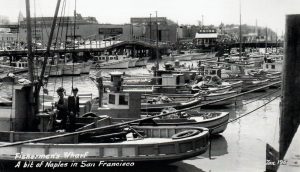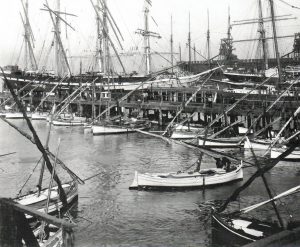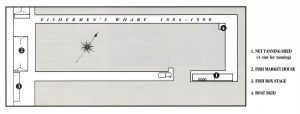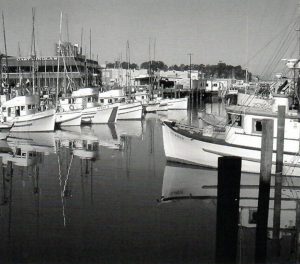By John C. Muir
Excerpt from the Sea Letter, Summer 2000 #58
Amid the dramatic transformations of the San Francisco waterfront in recent years, one classic San Francisco locale has resisted change: Fisherman’s Wharf. The primary tourist attraction of the city, with its rows of colorful street vendors, seafood restaurants and sport fishing boats, seems a timeless fixture of the waterfront landscape.
History, however, tells another story. From the earliest days of the San Francisco waterfront, Fisherman’s Wharf has been evolving. Both its location and its layout were shifted repeatedly between 1870 and 1930 to make way for the almost constant construction of the city’s shipping wharves and seawalls. The boats that lined Fisherman’s Wharf also changed, reflecting the dyna mic nature of the San Francisco Bay fisheries. Fortunately, the one thing about Fisherman’s Wharf that has remained constant is its picturesque allure. Hundreds of photographs of Fisherman’s Wharf from all its different eras survive today and provide a valuable chronicle of its transformation.
Commercial fishing along the waterfront grew with the burgeoning city of San Francisco. From the days of the Gold Rush, the city’s markets and restaurants have been supplied with fresh seafood by a growing hodgepodge of boats and newly-arrived fishermen from around the world.
As early as 1856, a small village of Chinese immigrants along the south ern waterfront provided for themselves and Chinatown’s fish markets using sampans and small junks built at the water’s edge. European immigrants and Americans from the East Coast pursued salmon, flounder, crabs and herring using a panoply of small boats such as sloops, whitehalls, sailing smacks and modified ships’ boats.
By the late 1860s, successive waves of Italian immigration brought hundreds of fishermen from the coastal villages near the city of Genoa into San Francisco. They also built fishing boats in the tradition of their native land, called “silenas” by the fishermen, but later more widely known as “San Francisco feluccas.” The seaworthiness of these small, lateen-rigged vessels was a perfect match for the rugged waters of the San Francisco Bay and contributed to the success of their skilled owners. The felucca quickly became the principal vessel in the fishing fleets moored along the San Francisco waterfront.
The earliest recorded site of the growing fleet of feluccas was located at the India Dock at the foot of Vallejo and Green Streets. Here, in the inside basin of a small rectangular pier, the fleet shared pier space with a variety of larger vessels. With the practice of photography still in its nascence, there are only a few existing images of this multi-use wharf, and all of these were taken from far enough away to obscure the details of the fleet tucked in behind its sheltering piles. Not until after 1884, the year the fleet was moved to the new state-owned wharves at the foot of Union and Greenwich streets.
1915 – 1930
By 1930 the marine engine had completely taken hold of Fisherman’s Wharf. The universality of its acceptance by then is reflected in the uniformity of vessel types along the wharf. The clipper-bowed Monterey fishing boats were ubiquitous. Their bluff sterns countered the tendency of vessels to squat under the drive and the weight of the engine; their dramatically rising, hollow-sectioned clipper bows proved perfect for driving through waves under power; and their small amidship wheelhouses provided protection on longer journeys into the deeper, rougher waters of the Bay. These traits assured their popularity as a universal, multipurpose vessel, used in all the fisheries for trawling, trolling, crabbing and gillnetting.
Their efficiency and the increased efficiency of distribution networks encouraged a boom for the fisheries held in check only by the ravages of the Great Depression. The products of the Bay were transported from the piers of San Francisco’s Fisherman’s Wharf by truck, rail, and ship throughout the West Coast and the rest of country. Many of the traditional marketing facilities of the older Fisherman’s Wharf, such as the Fish Market building, were replaced by industrial processing and packing facilities.
To accommodate the new facilities of the 1920s and 1930s, Fisherman’s Wharf was enlarged into three basins, with Jones Street filled in along what once was the protective riprap at the Western opening of the original basin. The old Southern pier extended all the way to the new Jones Street, requiring the Montereys to travel under the pier. Thus many of the vessels during this period feature hinged, or tabernacle, masts, that they would drop to pass under the pier. To accommodate the heavier Montereys, the light ramps of the Fisherman’s Wharves of the past were abandoned in favor of a large, heavily constructed boat skid leading right up to the boat-building shops of Castagnola, Labruzzi and Genoa, and the machine shop of Boicelli and Boss. Here the Montereys were built and repaired, and their dependable, single-cylinder marine engines serviced, insuring the longevity and productivity of the hard working fleet.
From the 1930s until now, still further changes have affected our Fisherman’s Wharf. Many of the names involved in the fisheries then, such as Castagnola, Tarantino and Alioto are still present, having traded in the tenuous fortunes of the fisherman’s life for the steadier, more lucrative fish distribution and restaurant businesses. New waves of immigration have brought Southeast Asian fishermen to our wharves, fishing to supply the live fish markets of Chinatown and the Tenderloin. Sport fishing boats and tour boats now vie for space with the local commercial fishing fleets, while these in turn shift and jostle to make room pierside for visiting vessels of the transient herring and salmon fleets of the Pacific Coast. Even today, piles are being driven to expand the docking space for these industrious fleets, and new state-of-the-art processing and packing facilities are being constructed.
As Fisherman’s Wharf continues its long tradition of change, traces of its past remain. Many of the structures and some of the boats that played such a central role in San Francisco’s fishing community of the early twentieth century can still be seen along the waterfront. These provide a tangible and moving connection between the past and the present chapters of the dynamic story of Fisherman’s Wharf.





